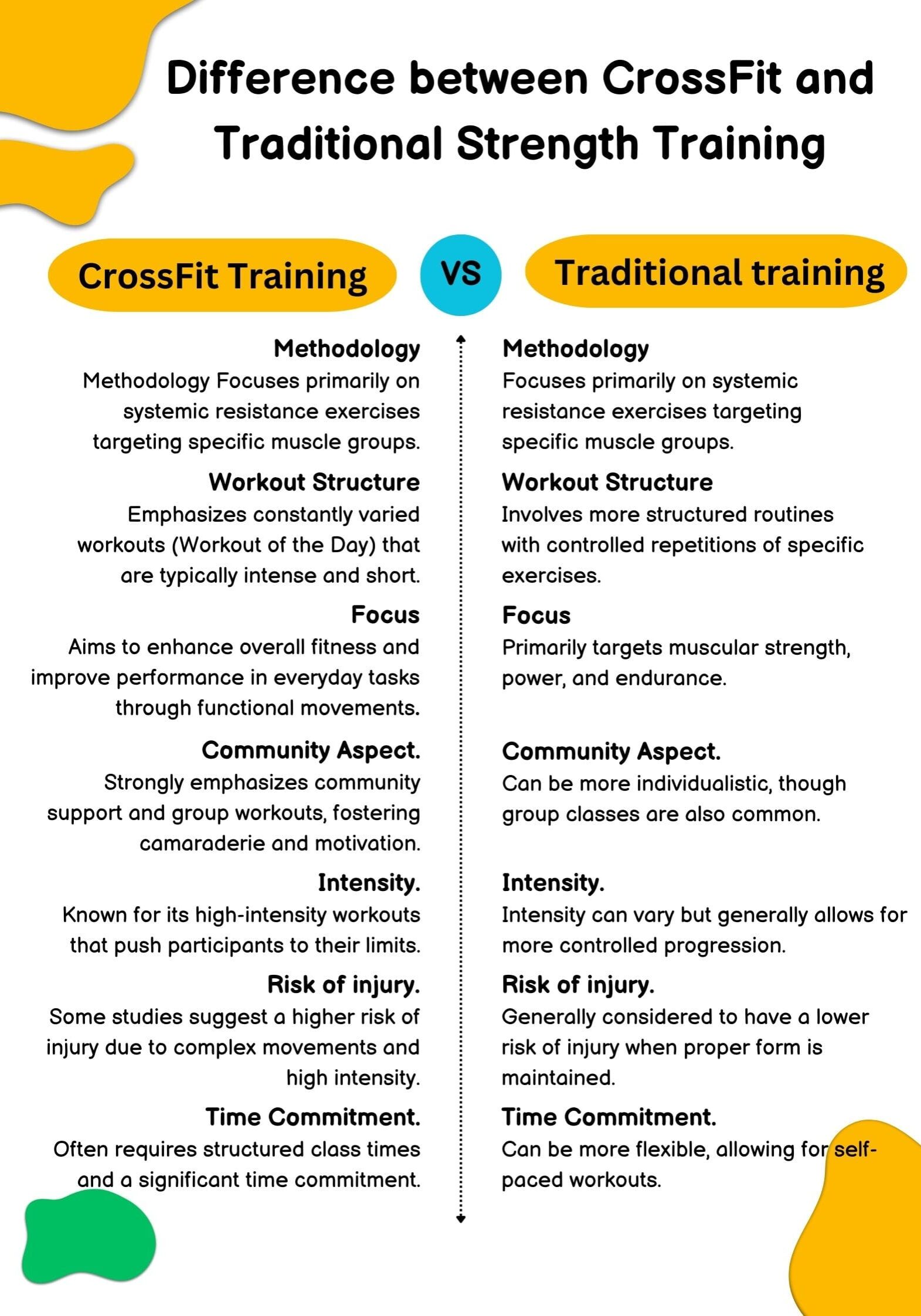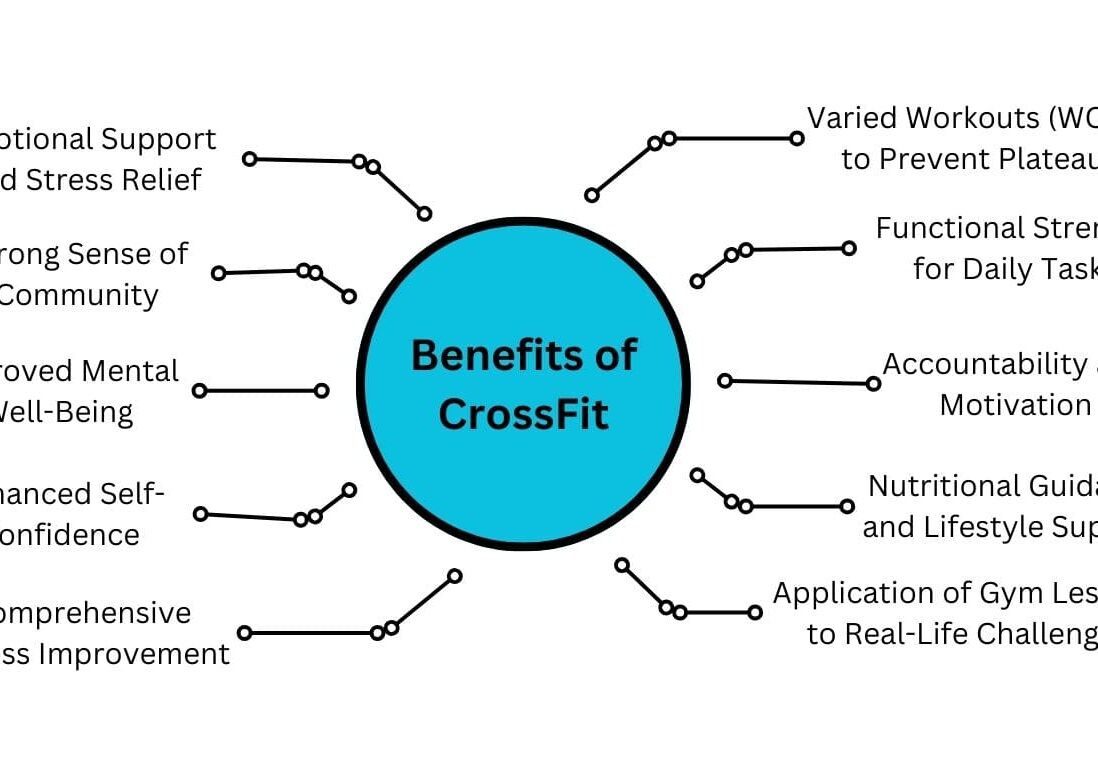
CrossFit Compared to Normal Strength and Conditioning Training
Are you wanting to get in shape, lose weight, and improve your fitness level, or are you an experienced fitness buff re-evaluating your routine? Whether you're a beginner or a seasoned athlete, understanding different training approaches is crucial for achieving your fitness goals.
CrossFit is a dynamic fitness program that combines high-intensity interval training (HIIT), strength exercises, and functional movements. It's designed to challenge participants at all levels, offering varied workouts that aim to improve overall fitness and real-world physical capabilities.
Traditional strength training, often seen in conventional gyms, focuses on building muscle mass and increasing strength. This approach typically involves exercises that target specific muscle groups, often using heavy weights or resistance machines to progressively overload muscles.
Conditioning training, which can be an element of both CrossFit and traditional programs, emphasizes improving overall fitness, endurance, and functional movements. It often incorporates a variety of exercises to enhance cardiovascular health, agility, and stamina.
This article gives you a detailed look at how CrossFit and traditional strength training compare. We'll break down the key differences, advantages, and potential drawbacks of each approach. By understanding what each type of training offers, you'll be better equipped to choose the one that fits your personal fitness goals and lifestyle. Whether you're just starting out or looking to change up your routine, this information will help you make the best choice for your health and fitness journey.
How did CrossFit and Normal Strength and Conditioning Training originate and evolve over time?
Normal Strength and Conditioning Training
Traditional strength and Conditioning training has roots that date back centuries, evolving from early practices of physical conditioning used by warriors and athletes. In the late 19th and early 20th centuries, weightlifting became formalized as a sport, leading to the development of weight training techniques aimed at building muscle and strength through resistance exercises.
The popularity of traditional strength training received a significant boost with the rise of professional bodybuilding competitions, particularly Mr. Olympia. This prestigious title, first awarded in 1965 in Brooklyn, New York, has become the pinnacle of achievement in men's bodybuilding. The competition has evolved into a global event featuring top bodybuilders from around the world. Iconic figures such as Larry Scott, Sergio Oliva, and Arnold Schwarzenegger have not only won the Mr. Olympia title but have also played a crucial role in popularizing traditional strength training methods. Their impressive physiques and training regimens have inspired countless individuals to adopt strength training techniques, further cementing the importance of traditional strength and conditioning in the fitness world.
This blend of competitive bodybuilding and traditional strength training principles has continued to influence workout routines and fitness goals for enthusiasts at all levels.
CrossFit
CrossFit was founded in the early 2000s by Greg Glassman, who sought to create a high-intensity fitness regimen that combined elements of weightlifting, cardiovascular exercises, and functional movements. It’s a workout method that combines weightlifting, cardio, and bodyweight exercises into intense workouts. What sets CrossFit apart is its game-like aspect, which culminates in the CrossFit Games. The Games began in 2007 and have evolved significantly since then to determine the fittest individuals on earth. The concept of the Games is rooted in the ideas of CrossFit's founder, Greg Glassman, who started promoting the fitness methodology in the 1970s. The Games have become a comprehensive test of fitness, featuring various physical challenges and competitions.
This competitive element isn't limited to elite athletes; it's integral to the CrossFit experience for participants at all levels. From daily workouts where individuals can track and compare their performance, to local and regional competitions, CrossFit offers a way for everyone to participate in a fitness 'game'. This approach turns exercise into an engaging, measurable, and community-driven activity, contributing to CrossFit's rapid growth and passionate following since its official founding in the early 2000s.
CrossFit vs Normal Strength and Conditioning Training: Which Is Right for You?
Choosing the right workout routine is crucial for achieving your fitness goals efficiently. Both CrossFit and traditional strength and conditioning training offer unique paths to fitness, each with its own strengths. To determine which is right for you, consider the following:
Choose Traditional Strength and Conditioning if you:
- Have specific strength or muscle-building goals
- Prefer a more predictable, progressive routine
- Want to focus on particular muscle groups
- Enjoy working out independently
- Have concerns about the intensity of CrossFit
Choose CrossFit if you:
- Enjoy varied, high-intensity workouts
- Thrive in a community-driven environment
- Want to improve overall functional fitness
- Like the idea of competing against yourself and others
- Prefer structured group classes
Ultimately, the best workout is the one that aligns with your specific needs, preferences, and keeps you motivated. Some individuals may even benefit from a combination of both approaches.
If you’re looking for a comprehensive training schedule that can cater to either of these fitness methodologies, consider exploring options like the one offered at PhuketFit. Our diverse schedule is designed to accommodate various fitness levels and preferences, making it easier for you to find a program that aligns with your fitness goals, whether you’re drawn to the dynamic challenges of CrossFit or the structured progression of strength training.
Some of the exercises for Crossfit training.
Crossfit training is a combination of different types of exercise to make a solid program. Different mixes can do different things for your body. You can see some of these exercises here, or click here to learn more.
Pros and Cons for CrossFit and Traditional strength training.
In conclusion, whether CrossFit or traditional strength and conditioning training is better for you depends on your personal fitness goals, preferences, and lifestyle. By considering the pros and cons of each, you can choose a path that will keep you motivated, challenged, and moving towards your goals.
CrossFit Pros
- Community-driven and supportive environment
- Varied workouts keep training engaging
- Focus on overall fitness and functional strength
CrossFit Cons
- Potential for injury if not properly supervised
- Can be intimidating for beginners
- Requires significant time commitment
Traditional Strength Training Pros
- Targeted workouts allow for focused muscle development
- Structured routines make progress easy to track
- Generally lower risk of injury when proper form is maintained
Traditional Strength Training Cons
- May become monotonous over time
- Lacks the community aspect found in CrossFit gyms
- Progress can be slower for overall fitness goals
What are some of the equipment used by CrossFit and Traditional Training?
The equipment and environment in which you train can significantly impact your workout experience and results.
CrossFit Equipment
- Kettlebells for swings, deadlifts, and snatches
- Plyo boxes for jump training
- Rope climbs for upper body strength
- Rowing machines for cardiovascular workouts
- Barbells and free weights for lifting exercises
Traditional Strength Training Equipment
- Barbells and dumbbells for a wide range of exercises
- Weight machines for targeting specific muscle groups
- Bench press for chest, shoulder, and tricep development
- Squat racks for leg strength and overall body conditioning
What are the main risks and considerations to keep in mind when engaging in CrossFit training?
CrossFit, while celebrated for its high-intensity workouts and community-driven environment, carries inherent risks that participants should consider.
Risk of Injury
One of the primary concerns associated with CrossFit is the increased risk of injury due to its demanding nature. A study conducted by Dr. Brian A.G from Kennesaw State University in 2013 found that approximately 30 percent of CrossFit participants reported suffering from some form of injury within a year, particularly those who engaged in the workouts 3 to 5 days per week. Common injuries include shoulder, back, knee, and elbow issues, often attributed to the high intensity and complexity of the movements performed. For instance, overhead lifting exercises, such as shoulder presses and clean-and-jerks, can lead to shoulder injuries, while deadlifts and heavy squats can result in back injuries. Additionally, a Brazilian study from Orthopaedic Journal of Sports Medicine in August 2016 found that injury rates among CrossFit athletes were comparable to those in other sports, suggesting that the risk may not be significantly greater than in traditional strength training or weightlifting. However, improper form and a lack of adequate supervision can exacerbate the likelihood of injuries, particularly for beginners.
Time Commitment and Intensity
CrossFit workouts are typically structured and require a significant time commitment, which can be a challenge for individuals with busy schedules. Moreover, the high-intensity nature of these workouts may not be suitable for everyone, particularly those with pre-existing injuries, chronic conditions, or limited mobility. Newcomers may find the pace and complexity intimidating, which can deter them from fully engaging in the program.
Need for Proper Technique
To mitigate the risks associated with CrossFit, it is essential for participants to focus on mastering proper technique and form. Beginners are encouraged to start slowly, gradually increasing the weight and intensity of their workouts while seeking guidance from certified CrossFit coaches. This approach can help ensure a safer training experience and reduce the chances of injury.
Conclusion
Interestingly, the dichotomy between CrossFit and traditional strength training isn't always clear-cut. Many fitness enthusiasts find value in combining elements from both approaches, creating a hybrid routine that leverages the strengths of each method. This synthesis allows for a comprehensive fitness regimen that addresses various aspects of physical health, from functional strength to targeted muscle development.
Ultimately, the most effective fitness approach is one that aligns with your personal goals, preferences, and lifestyle. By understanding the differences of both CrossFit and traditional strength training, you can make an informed decision that propels you towards your fitness aspirations, whether that involves high-intensity functional workouts, focused strength development, or a carefully crafted combination of both.



